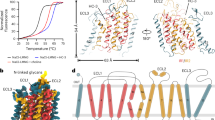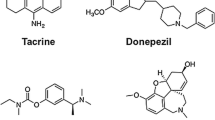Abstract
A topographic model of the ligand binding site of the choline transporter was deduced from inhibition studies with the help of CPK molecular models. It is posited that there are two identical or closely similar hydrophilic anionic sites separated from each other by an hinged, essentially planar but conformationally flexible cationic hydrophobic domain. Subsequently to attachment of external choline to either one of the anionic sites, both sites cooperate in enveloping the ligand by a Venus fly-trap mechanism. This leads to rapid configurational changes by which the closed-liganded form of the transporter opens up to the interior to release the bound choline. Intracellular K+, a ligand for the choline-binding site, is proposed to be countertransported by a reversal of the above mechanism.
Similar content being viewed by others
References
Simon, J. R., Atweh, S., and Kuhar, M. J. 1976. Sodium-dependent high affinity choline uptake: a regulatory step in the synthesis of acetylcholine. J. Neurochem. 26:909–922.
Jope, R. S. 1979. High affinity choline transport and acetylCoA production in brain and their roles in the regulation of acetylcholine synthesis. Brain Res. Rev. 1:313–344.
Lijian, Y., Nishino, H., and Iwashima, A. 1988. Stimulation of choline transport in cultured cells induced by 12-O-tetradecanoylphorbol-13-acetate: one of the earliest phenomena induced by the tumor promoter. Oncology 45:326–330.
Breer, H. 1983. Choline transport by synaptosomal membrane vesicles isolated from insect nervous tissue. FEBS Letters 153:345–348.
Meyer, E. M., and Cooper, J. R. 1982. High-affinity choline transport in proteoliposomes derived from rat cortical synaptosomes. Science 217:843–845.
O'Regan, S., and Vyas, S. 1986. Modifications in choline transport activity as a function of membrane potential and the sodium gradient. J. Physiol., Paris 81:325–331.
Vyas, S., and O'Regan, S. 1985. Reconstitution of carrier-mediated choline transport in proteoliposomes prepared from presynaptic membranes ofTorpedo electric organ, and its internal and external ionic requirements. J. Membrane Biol. 85:111–119.
Meyer, E. M., West, C. M., and Chau, V. 1986, Antibodies directed against ubiquitin inhibit high affinity [3H]choline uptake in rat cerebral cortical synaptosomes. J. Biol. Chem. 261:14365–14368.
Tamaru, M., and Roberts, E. 1988. I. Structure-activity studies on inhibition of choline uptake by a mouse brain synaptosomal preparation: basic data. Brain Res. 473:205–226.
Quiocho, F. A. 1990. Atomic structures of periplasmic binding proteins and the high-affinity active transport systems in bacteria. Phil. Trans. R. Soc. Lond. B 326:341–351.
Deves, R., Reyes, G., and Krupka, R. M. 1986. The carrier reorientation step in erythrocyte choline transport: pH effects and the involvement of a carrier ionizing group. J. Membrane Biol. 93:165–175.
Krupka, R. M., and Deves, R. 1988. The choline carrier of erythrocytes: location of the NEM-reactive thiol group in the inner gated channel. J. Membrane Biol. 101:43–47.
Deves, R., and Krupka, R. M. 1987. Effects on transport of rapidly penetrating, competing substrates: activation and inhibition of the choline carrier in erythrocytes by imidazole. J. Membrane Biol. 99:13–23.
Krupka, R. M. 1989. Testing transport models and transport data by means of kinetic rejection criteria. Biochem. J. 260:885–891.
Mao, B., Pear, M. R., McCammon, J. A., and Quiocho, F. A. 1982. Hinge-bending in L-arabinose-binding protein. J. Biol. Chem. 257:1131–1133.
Vos, J., Kuriyama, K., and Roberts, E. 1968. Electrophoretic mobilities of brain subcellular particles and binding of γ-aminobutyric acid, acetylcholine, norepinephrine, and 5-hydroxytryptamine. Brain Res. 9:224–230.
Kuriyama, K., Roberts, E., and Vos, J. 1968. Some characteristics of binding of γ-aminobutyric acid and acetylcholine to a synaptic vesicle fraction from mouse brain. Brain Res. 9:231–252.
Vos, J., Kuriyama, K., and Roberts, E. 1969. Distribution of acid mucopolysaccharides in subcellular fractions of mouse brain. Brain Res. 12:172–179.
Krupka, R. M., and Deves, R. 1980. The electrostatic contribution to binding in the choline transport system of erythrocytes. J. Biol. Chem. 255:8546–8549.
Deves, R., and Krupka, R. M. 1979. The binding and translocation steps in transport as related to substrate structure. A study of the choline carrier of erythrocytes. Biochim. Biophys. Acta 557:469–485.
Martin, K. 1969. Effects of quaternary ammonium compounds on choline transport in red cells. Br. J. Pharmacol. 36:458–469.
Irwin, M. J., Nyborg, J., Reid, B. R., and Blow, D. M. 1976. The crystal structure of tyrosyl-transfer RNA synthetase at 2.7 Å resolution. J. Mol. Biol. 105:577–586.
Fersht, A. R., Mulvey, R. S., and Koch, G. L. E. 1975. Ligand binding and enzymic catalysis coupled through subunits in tyrosyl-tRNA synthetase. Biochemistry 14:13–18.
Bosshard, H. R., Koch, G. L. E., and Hartley, B. S. 1975. Aminoacyl-tRNA synthetases fromBacillus stearothermophilus. Asymmetry of substrate binding to tyrosyl-tRNA synthetase. Eur. J. Biochem. 53:493–498.
Lindborg, B., Crona, K., and Dahlbom, R. 1984. Troxoniumlike inhibitors of the high affinity uptake of choline in mouse brain synaptosomesin vitro. Acta Pharm. Suec. 21:271–294.
Holden, J. T., Rossier, J., Beaujouan, J. C., Guyenet, P., and Glowinski, J. 1975. Inhibition of high-affinity choline transport in rat striatal synaptosomes by alkyl bisquaternary ammonium compounds. Molecular Pharmacology 11:19–27.
Barker, L. A., and Mittag, T. W. 1975. Comparative studies of substrates and inhibitors of choline transport and choline acetyltransferase. J. Pharm. Exptl. Therap. 192:86–94.
Liron, Z., Wong, E., and Roberts, E. 1988. Studies on uptake of γ-aminobutyric acid by mouse brain particles; toward the development of a model, Brain Res. 444:119–132.
Zilberstein, D., Ophir, I. J., Padan, E., and Schuldiner, S. 1982. Na+ gradient-coupled porters ofEscherichia coli share a common subunit. J. Biol. Chem. 257:3692–3696.
Thom, R. 1975.Structural Stability and Morphogenesis (translated from the French edition, as updated by the author, by D. H. Fowler; Foreword by C. H. Waddington), W. A. Benjamin, Reading, MA.
Martin, K. 1972. Extracellular cations and the movement of choline across the erythrocyte membrane. J. Physiol. 224:207–230.
Saltarelli, M. D., Lowenstein, P. R., and Coyle, J. T. 1987. Rapid in vitro modulation of [3H]hemicholinium-3 binding sites in rat striatal slices. Eur. J. Pharmacol. 135:35–40.
Antonelli, T., Beam, L., Bianchi, C., Pedata, F., and Pepeu, G. 1981. Changes in synaptosomal high affinity choline uptake following electrical stimulation of guinea-pig cortical slices: effect of atropine and physostigmine. Br. J. Pharmacol. 74:525–531
Hatch, G. M., Stevens, W. K., and Choy, P. C. 1988. Effect of amino acids on choline uptake and phosphatidylcholine biosyntehsis in the isolated hamster heart. Biochem. Cell Biol. 66:418–424.
Andresen, P. A., Kaasen, I., Styrvold, O. B., Boulnois, G., and Strom, A. R. 1988. Molecular cloning, physical mapping and expression of thebet genes governing the osmoregulatory choline-glycine betaine pathway ofEscherichia coli. J. Gen. Microbiol. 134:1737–1746.
Nikawa, J.-I., Hosaka, K., Tsukagoshi, Y., and Yamashita, S. 1990. Primary structure of the yeast choline transport gene and regulation of its expression. J. Biol. Chem. 265:15996–16003.
Author information
Authors and Affiliations
Additional information
Special issue dedicated to Dr. Morris H. Aprison.
Rights and permissions
About this article
Cite this article
Roberts, E., Tamaru, M. The ligand binding site of the synaptosomal choline transporter: A provisional model based on inhibition studies. Neurochem Res 17, 509–528 (1992). https://doi.org/10.1007/BF00969899
Accepted:
Issue Date:
DOI: https://doi.org/10.1007/BF00969899




